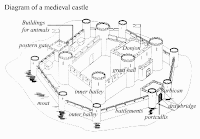Medieval castles were made of wood at first but were later built with stone. This is for many reasons. They were more sturdy than wooden castles, they were more sophisticated, and they didn't catch fire as easily. Although stone castles had better quality, they also costed a
lot more to build! This is because the stone had to be imported from
very far away, unlike the wood needed to build a wooden castle.
Besides the material the castles were made of, their actual look wasn't much different. Most of the castles you see have the
same features. For example, they
both have moats, drawbridges, and small windows for shooting arrows through. These things naturally give castles that
"common castle" look, even though they are different castles!
You can
easily identify castles! Especially when you consider each part of the castle! A castle has many different rooms. Some have more than others, but a typical castle includes a dungeon
(like a cell), the moat
(a deep and wide ditch filled with water) surrounding the castle, a drawbridge
(a walk way to get across the moat), the inner baily
(the inner wall), and the outer baily
(the outer wall). Hopefully now you can tell what kind of rooms a typical castle has!


